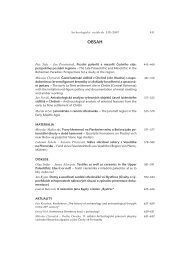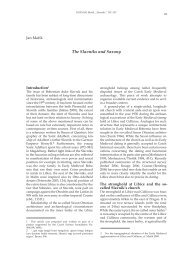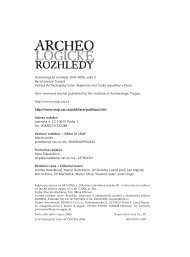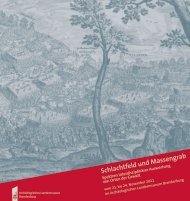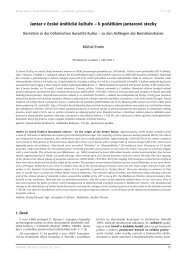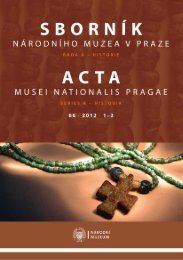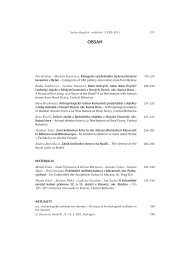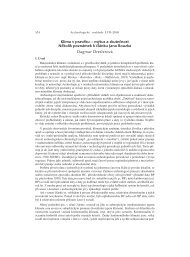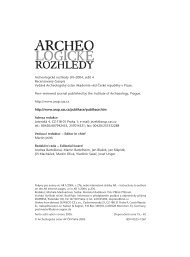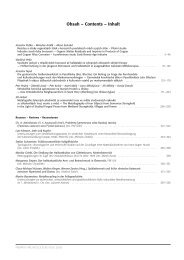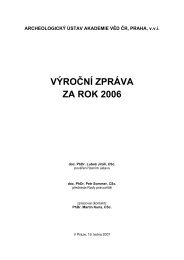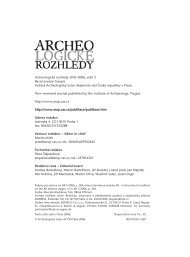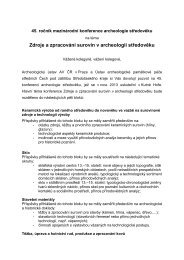116B¤EZINOVÁ –POPPOVÁ URBANOVÁ: Fragmenty textilu na bronzovém vûdru …Košnar, L. – Waldhauser, J. 1997: Archeologie Germánů v Pojizeří a v Českém ráji. Praha – Mladá Boleslav.Krekovič, E. 1993: Pohrebný rítus a sociálna struktura. In: E. Krekovič ed., Kultovné a sociálne aspektypohrebného rítu od najstarších čias po súčasnost, Bratislava, 6–10.Landovy zápisníky: Archiv Oddělení prehistorie a protohistorie Národního muzea v Praze.Laux, F. 1992: Überlegungen zu den germanischen Fürstengräbern bei Marwedel, Gde. Hitzacker,Kr. Lüchow-Dannenberg. Bericht der Römisch-Germanisches Komission 73, 315–376.Maik, J. 1988: Wyroby włókiennicze na Pomorzu z okresu rzymskiego i ze średniowiecza. Acta ArchaeologicaLodziensia 34. Wrocław – Warszawa – Kraków – Łódź.— 2001: Recent textile finds of the Roman period in Poland. In: P. Walton Rogers – L. Bender Jørgensen –A. Rast-Eicher eds., The Roman textile industry and its influence, Oxford, 105–112.— 2005: Tkaniny z grobu książęcego v Leśnie. In: H. Rząska – K. Walenta edd., Brusy i okolice w pradziejachna tle porównawczym, Brusy, 98–111.— 2007: Tkaniny z pomorskich cmentarzysk kultury wielbarskiej w świetle najnowszych badań. In:M. Fudziński – H. Paner, Nowe materiały i interpretacje. Stan dyskusji na temat kultury wielbarskiej,Gdańsk, 97–108.Motyková–Šneidrová, K. 1967: Weiterentwicklung und Ausklang der älteren römischen Kaiserzeit in Böhmen.Fontes Archaeologici Pragenses 11. Pragae.Novotná, M. 2008: Analýza vzorků z bronzového vědra z Řepova inv. č. 52979. Nepubl. zpráva depon. in:Oddělení prehistorie a protohistorie NM Praha.Peška, J. – Králík, M. – Selucká, A. 2006: Rezidua a otisky organických látek v korozních produktech mědia jejích slitin. Památky archeologické 97, 5–46.Peška, J. – Tejral, J. 2002: Königsgrab von Mušov. Mainz.Sakař, V. 1970: Roman Imports in Bohemia. Fontes Archaeologici Pragenses 14. Pragae.Schlabow, K. 1976: Textilfunde der Eisenzeit in Norddeutschland. Neumünster.Schönfelder, M. 1994: Bear – Clar in Germanic gratis. Oxford Journal of Archaeology 13, 217–227.Sklenář, K. 2003: Archiv nálezových zpráv Oddělení prehistorie a protohistorie Národního muzea v Praze.In: Zprávy České archeologické společnosti – supplément 51, Praha, 25.Šimek, E. 1923: Čechy a Morava za doby římské. Praha.Walton, P. – Eastwood, G. 1988: A brief guide to the cataloguing of archaeological textiles. London.Textile fragments on a Roman period bronze bucket from Řepov,Central BohemiaTwo larger metal vessels positioned next to each other–a bronze bucket and a pan with a maenadhead and a hang ring–were found at a depth of nearly 1 m at the eastern edge of Řepov municipality(Mladá Boleslav distr.) in 1904. One of the vessels was filled with smaller items. The find wasinterpreted as being the remains of a skeleton grave of a prominent individual from the ruling class(judging by the nature of the grave items, probably a man), who was probably buried here in the firsthalf of the 2 nd century (B2 horizon). The assemblage was handed over to the National Museum inPrague in 1909, in whose collections it is still filed under Inv. no. 52968–52982. In addition to theaforementioned two vessels, the assemblage also contains a colander and ladle set (the ladle stampedwith the lettering L COMPITVRICIN and ///• POLIBI) and a shallow bronze bowl, bronze forgingsfor two drinking horns decorated with silver rivets, a ring, razor and scissors (Karasová 1998, 79;Sakař 1970, 40; Motyková-Šneidrová 1967, 40).The surface of the bucket is a veritable treasury of organic remains. Almost half the outer surfaceis covered by fragments permeated with corrosion or impressions of various textiles, twisted yarn,grass impressions and remains of animal hair, which is the only thing also to have been preservedon the inner surface of the walls and base of the vessel. Most interesting are the remains of textiles,which were made using several textile techniques: most of the vessel surface is covered with a finefabric laced in a plain weave and by free twisted yarns without interlacing; the outer side of the basefeatures two small impressions of fabric with twill weave and a small fragment of band made ona tablet loom.
<strong>Archeologické</strong> <strong>rozhledy</strong> LXI–<strong>2009</strong> 117The most frequent method by which prehistoric textiles have been preserved in the Bohemianenvironment are demonstrated by the remains of textile structures which have been found in corrodedproducts of metal items made from iron, bronze, copper, lead or silver. Products of organic origin thatwere close to a metal item at the time of corrosion development, can be preserved in three variousforms – as the remains of the actual organic material, as a mineralised form of original organic material(a pseudomorph), or as the imprint of the outer surface of the organic item in corrosion layers(Peška – Králík – Selucká 2006, 5, 38).The results of the textile technological research are summarised in the table:Type of textile Weave Thread count Twisting of yarn Yarn thickness Textile raw materialTwisted yarn No – 2Z/S Twisted yarn: 1 mm Cellulose/proteininterlacing Individual strands: (flax/silk)0.5 mmFabric with plain One set: One set: Z One set: Celluloseplain weave 20 yarns/10 mm Second set: Z 0.3 – 0.4 mm (probably flax)Second set:Second set:18 yarns/10 mm 0.5 mmFabric with Twill 2/1 Warp: ? Warp: Z Warp: 0.6 mm Undetermined, due totwill weave (doubled Weft: ? Weft: S Weft: 0.6 mm marked degradationwarp end)of fibres, it was notpossible to take therequired sample.Band Made on Indefinable Indefinable Indefinable Undetermined, due toatabletmarked degradationloomof fibres, it was notpossible to take therequired sample.In the case of the bucket from Řepov, organic remains only survived on one half of the outer surfaceof the vessel, the other part of the surface is smooth and free of all remains. It cannot be refuted(or proven) that the organic remains were originally preserved on the entire surface of the bucketand that their removal occurred during an undocumented attempt to clean the surface of the vesselafter finding it. No remains of textiles or other organic materials have been preserved on any otheritem from the Řepov assemblage set.An Olympus SZX 9 stereomicroscope and an Olympus BX60 transmitted and reflected lightmicroscope with a trinocular head were used for a detailed analysis. The textile raw materials wereanalysed through microscopic observance of the fabric structure and through infrared spectroscopy.The find of the organic remains is important in particular because it shows the variations of processingof textile fibres. The textile remains preserved on the bronze bucket from Řepov demonstratemost of the known weaving techniques that were used by Germanic tribes in northern Europe. Herewe encounter fine plain weave, twill and a band made on a tablet loom. The occurrence of productsmade using the last technique had not, to date, been previously recorded in the prehistoric periodon the territory of the Czech Republic.English by Robin CasslingHELENA BŘEZINOVÁ, <strong>Archeologický</strong> <strong>ústav</strong> <strong>AV</strong> <strong>ČR</strong>, Praha, v.v.i., Letenská 4, CZ-11801 Praha 1brezinova@arup.cas.czKRISTÝNA POPPOVÁ URBANOVÁ, Oddělení prehistorie a protohistorie, Národní muzeum, Václavské nám. 68,CZ-11579 Praha 1; kristyna_urbanova@nm.cz



